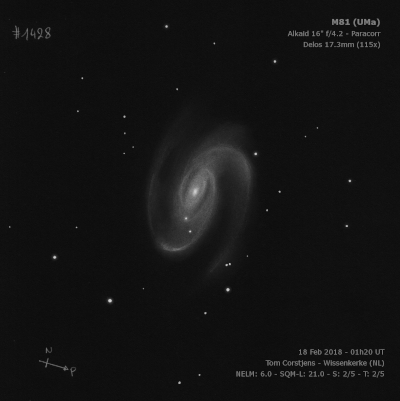Bode's Galaxy
Bode's Galaxy

Johann Bode discovered M81 = NGC 3031 = h649, along with M82, on 31 Dec 1774. Pierre Méchain independently discovered M81 in Aug 1779. On 30 Sep 1802, William Herschel recorded "vB, eL; it very nearly fills all the field, it loses itself imperceptibly, mE np sf; I can trace it nearly 1/2° in extent beyond the brightest part." On 28 Oct 1831 (sweep 377), John Herschel wrote, "eB; eL; E, pos = 156°, gb and svmbM, with faint rays of light nearly to extremities of field (15'). The most condensed part is 4' l and 3' br." He mistakenly called this galaxy M82 in the Slough Catalogue.
200/250mm - 8" very bright, bright core, large oval halo, elongated NW-SE, two faint stars involved.
300/350mm - 13.1" (1/18/85): extremely faint arm attached at the southeast end near two stars and curves to the east.
400/500mm - 17.5" (3/23/85): very bright, very large, elongated 2:1 NNW-SSE, about 16'x8', large oval bright middle, bright core, nearly stellar nucleus. Two mag 11.5 and 11.9 stars are superimposed in the halo at the south edge of the core. An easily visible spiral arm is attached near these two stars at the south end of the core. This arm curves due north along the east side and is well separated from the main body. A second arm was suspected on 10/12/85 as a short extension curving around the NNW end towards a mag 12 star at the WNW edge of the halo and was described as "shorter and much less prominent, though definitely seen" on 1/31/87. Mag 8.7 SAO 15020 (∑1386 = 9.3/9.3 at 2") lies 10' SSW and the striking double star ∑1387 = 10.7/10.7 at 9" is 8' SSW. Forms a very striking pair at low power with M82 37' N. The bright supernova 1993j was located 3' SSW of the core and formed a right triangle with the two mag 11.5/11.9 stars south of the core.
900/1200mm - 48" (4/15/10): dazzling view of M81 at 267x (21mm Ethos) and 330x (17mm Nagler). The galaxy is elongated 2:1 NNW-SSE and extends at least 20'x10'. The brightness level increases gradually to the center from the large, very bright oval core but is punctuated at the center by an extremely bright, quasi-stellar nucleus. A bright spiral arm attaches to the galaxy on the northwest end and bends abruptly to the south, passing across a mag 12 star located 5' NW of center. As it heads southeast, the arm separates from the main glow of the galaxy and can be traced as it passes just north of double star STF 1387 = 10.8/10.8 at 9", ending to the northeast of the striking double star STF 1386 = 9.3/9.3 at 2.1". The total length of this arm is ~15'. The second main arm is more prominent, attaching to the main body on the south end. This arm is much brighter in a narrow arc as it curves around at its south end. The southern arm is still relatively narrow with a very well defined edge as it sweeps NNW and gradually separates from the main body.
Holmberg IX was visible 10.5' E of the center of M81. With this dwarf galaxy centered in the eyepiece, the outer halo of M81 was visible near the edge of the field. At 330x it appeared very faint, fairly large, 2' diameter, round, low even surface brightness with no noticeable concentration. The galaxy is nestled within a kite asterism including a mag 13 star 1.3' S.
Notes by Steve Gottlieb